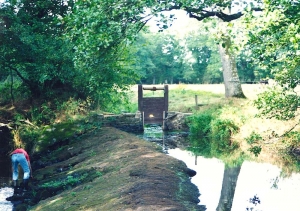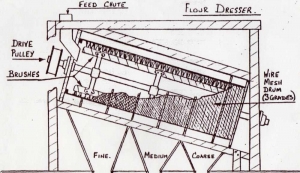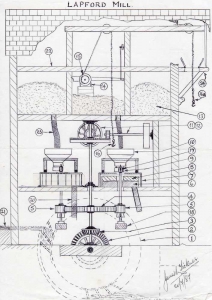
The weir is about 1km away!
The present mill building is said to have been built around 1880 after the previous one was destroyed by fire. That was built of cob, with a thatched roof and was only two floors high. The present one is built of stone, has four floors, and a slate roof.
The rivers Yeo and Dalch converge about half a mile from the mill and a weir at the confluence retains a head of water. A sluice gate at the weir controls water passing into the leat, which traverses through four fields to the mill. The leat falls with less of a gradient than the main river, and so arrives at the mill at about 14 feet above the river level to give a good drop through the water wheel.
The leat delivers water to the wheel at about 2 feet above the axle height. The wheel is therefore classed as a higher breast shot type. The wheel rims are 12 feet in diameter, made of cast iron, and each rim was cast in six segments by Messrs Dooley’s foundry in Exeter. The wheel has this name embossed on it together with that of Messrs Dicker of Chagford. Their wheels have been found over a large area of south west England. This wheel is believed to date from about 1845, having survived the fire.
Each bucket on the wheel is 6 feet long, 15 inches deep, and about 9 inches average width. This gives a volume of about 5 cubic feet, which equates to about 30 gallons or 300 lbs of water in each bucket. There are 42 buckets of which 10 are full at any instant. This equates to over a ton of water pushing the wheel around. The maximum power output from the shaft is thus probably about 8 horsepower.
The grain arrived at the mill by horse and cart, which stopped below the lucan, at the end of the mill. The sacks were then hoisted from the cart onto the top floor walkway where they were tipped into the first storage bin. This feeds into a winnowing machine on the floor below. The grain is beaten by paddles to remove the husks, which are blown out through a hole in the wall by a fan in the base of the winnower. The cleaned kernels drop into sacks and are then hoisted back to the top floor, where they are tipped into either of the other two bins.
Each of these bins feeds a hopper on each of the two millstones. The hoppers discharge into a wooden shoe which is shaken to distribute the grain evenly into the centre, the ‘eye’ of the millstone. Because of the constant chatter of the cam lobes against the shoe, this mechanism became known as the ‘Damsel’.
The lower millstone is stationary and is called the ‘Bedstone’. Only the upper stone (the ‘Runner’) rotates.
After gearing, the mill stones typically turned at 150 r.p.m. The miller had to adjust the flow of water to keep the wheel and the stones at the right speed by means of water and sluice gates. If the stones are too fast, friction will burn the flour and give a fire danger. If they are slow, the flour will not be ejected from the periphery of the stones, which will clog and give a similar undesirable result.
The stones are enclosed in a wooden frame known as the tun, which collects the flour as it is ejected from the stones. A piece of wood affixed to the side of the runner stone, sweeps the flour round to a chute and it then falls through sleeves into sacks on the floor below. The sacks were then hoisted up two floors to the bin floor.
The gap between the stones has to be accurately and finely adjusted, to produce the required quality of flour. This is done by a screw-jack which raises or lowers the huge beam (the ‘Tenter’), which supports the drive-shaft of the runner stone. Thus, the Miller “sets the Tenter”
If too low, the running stone will contact the bedstone, which produces grit in the flour and worn millstones, but worst of all is the ensuing friction heat and sparks. A fine fog of flour and air is a highly combustable mix, which is how so many mills were lost to fires.
If the gap is too large, then the resulting meal will be far too coarse. The miller aims to set a gap to suit the grist (grain) going in and the grade of the meal coming out.
The sacks are then tipped into a hopper which feeds into a dressing machine. This has an inclined drum lined with different sizes of wire mesh. There are long brushes on a shaft which rotates inside the drum, and sweeps the flour across the wire mesh. Below each section of mesh are funnels to direct each grade of flour into sacks on the floor below. These were then weighed, tallied, and stacked ready for dispatch.
The Miller usually charged his customers for his work by retaining a tythe (ie a ‘tenth’) of the meal produced from their grain. This led to many disagreements due to the variations in the amount of flour allegedly produced from a given quantity of grain. This discrepancy was mostly due to factors such as the type of grain and its condition, and not to mention the honesty and accuracy of the Miller!





